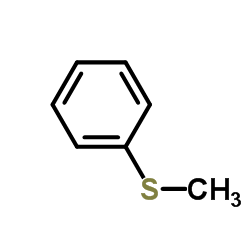Thioanisole

Thioanisole structure
|
Common Name | Thioanisole | ||
|---|---|---|---|---|
| CAS Number | 100-68-5 | Molecular Weight | 124.203 | |
| Density | 1.0±0.1 g/cm3 | Boiling Point | 193.0±0.0 °C at 760 mmHg | |
| Molecular Formula | C7H8S | Melting Point | −15 °C(lit.) | |
| MSDS | Chinese USA | Flash Point | 57.2±0.0 °C | |
| Symbol |

GHS07 |
Signal Word | Warning | |
|
Quantification of plasma HIV RNA using chemically engineered peptide nucleic acids.
Nat. Commun. 5 , 5079, (2014) The remarkable stability of peptide nucleic acids (PNAs) towards enzymatic degradation makes this class of molecules ideal to develop as part of a diagnostic device. Here we report the development of chemically engineered PNAs for the quantitative detection o... |
|
|
The influence of linker length on the properties of cathepsin S cleavable177Lu-labeled HPMA copolymers for pancreatic cancer imaging
Biomaterials 35(22) , 5760-70, (2014) N-(2-hydroxypropyl)-methacrylamide (HPMA) copolymers have shown promise for application in the detection and staging of cancer. However, non-target accumulation, particularly in the liver and spleen, hinders the detection of resident or nearby metastatic lesi... |
|
|
Calculating virtual log P in the alkane/water system (log P(N)(alk)) and its derived parameters deltalog P(N)(oct-alk) and log D(pH)(alk).
J. Med. Chem. 48 , 3269-79, (2005) Growing interest in the use of both the logarithm of the partition coefficient of the neutral species in the alkane/water system (log P(N)(alk)) and the difference between log P(N)(oct) (the logarithm of the partition coefficient of the neutral species in the... |
|
|
EPR and NMR spectroscopies provide input on the coordination of Cu(I) and Ag(I) to a disordered methionine segment.
J. Biol. Inorg. Chem. 20 , 719-27, (2015) Methionine motifs are methionine-rich metal-binding segments found in many human, yeast, and bacterial proteins involved in the transportation of copper ion to other cellular pathways, and in protecting copper from oxidation. Methionine motifs are found to bi... |
|
|
Position and length of fatty acids strongly affect receptor selectivity pattern of human pancreatic polypeptide analogues.
ChemMedChem 9(11) , 2463-74, (2014) Pancreatic polypeptide (PP) is a satiety-inducing gut hormone targeting predominantly the Y4 receptor within the neuropeptide Y multiligand/multireceptor family. Palmitoylated PP-based ligands have already been reported to exert prolonged satiety-inducing eff... |
|
|
Receptor-mediated uptake of boron-rich neuropeptide y analogues for boron neutron capture therapy.
ChemMedChem 10(1) , 164-72, (2014) Peptidic ligands selectively targeting distinct G protein-coupled receptors that are highly expressed in tumor tissue represent a promising approach in drug delivery. Receptor-preferring analogues of neuropeptide Y (NPY) bind and activate the human Y1 recepto... |
|
|
A peptide from human semenogelin I self-assembles into a pH-responsive hydrogel.
Soft Matter 11(2) , 414-21, (2014) The peptide GSFSIQYTYHV derived from human semenogelin I forms a transparent hydrogel through spontaneous self-assembly in water at neutral pH. Linear rheology measurements demonstrate that the gel shows a dominating elastic response over a large frequency in... |
|
|
Selective and Sensitive Sensing of Flame Retardant Chemicals Through Phage Display Discovered Recognition Peptide.
Nano Lett. 15 , 7697-703, (2015) We report a highly selective and sensitive biosensor for the detection of an environmentally toxic molecule, decabrominated diphenyl ether (DBDE), one of the most common congeners of the polybrominated frame retardants (polybrominated diphenyl ether (PBDE)), ... |
|
|
Redox inactive metal ion triggered N-dealkylation by an iron catalyst with dioxygen activation: a lesson from lipoxygenases.
Dalton Trans. 44 , 9847-59, (2015) Utilization of dioxygen as the terminal oxidant at ambient temperature is always a challenge in redox chemistry, because it is hard to oxidize a stable redox metal ion like iron(III) to its high oxidation state to initialize the catalytic cycle. Inspired by t... |
|
|
Nano-colloid printing of functionalized PLA-b-PEO copolymers: tailoring the surface pattern of adhesive motif and its effect on cell attachment.
Physiol. Res. 64 Suppl 1 , S61-73, (2015) In this study, we investigate the preparation of surface pattern of functional groups on poly(lactide) (PLA) surfaces through the controlled deposition of core-shell self-assemblies based on functionalized PLA-b-PEO amphiphilic block copolymers from selective... |